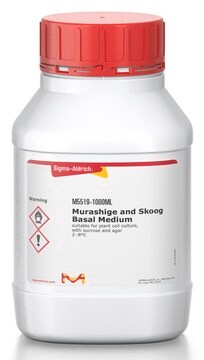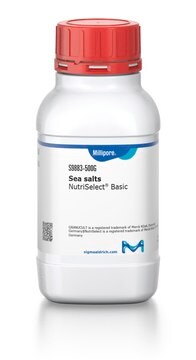G9903
Meerwasser-Anreicherungslösung nach Guillards (F/2)
50 ×, liquid, suitable for plant cell culture
Synonym(e):
F/2 Water Enrichment, Marine Enrichment Solution
About This Item
Empfohlene Produkte
Sterilität
sterile-filtered
Qualitätsniveau
Form
liquid
Konzentration
50 ×
Methode(n)
cell culture | plant: suitable
Anwendung(en)
agriculture
Versandbedingung
dry ice
Lagertemp.
−20°C
Allgemeine Beschreibung
Anwendung
Alternative Formulierung
Rekonstituierung
Phykologie-Medium zusammengesetzt und hergestellt aus Pulver
Lagerklassenschlüssel
12 - Non Combustible Liquids
WGK
WGK 1
Flammpunkt (°F)
Not applicable
Flammpunkt (°C)
Not applicable
Analysenzertifikate (COA)
Suchen Sie nach Analysenzertifikate (COA), indem Sie die Lot-/Chargennummer des Produkts eingeben. Lot- und Chargennummern sind auf dem Produktetikett hinter den Wörtern ‘Lot’ oder ‘Batch’ (Lot oder Charge) zu finden.
Besitzen Sie dieses Produkt bereits?
In der Dokumentenbibliothek finden Sie die Dokumentation zu den Produkten, die Sie kürzlich erworben haben.
Kunden haben sich ebenfalls angesehen
Protokolle
Phycology media can be prepared from concentrated solutions or from powdered salt mixtures. The concentrated solutions are complete, including vitamins, and should be stored frozen.
Unser Team von Wissenschaftlern verfügt über Erfahrung in allen Forschungsbereichen einschließlich Life Science, Materialwissenschaften, chemischer Synthese, Chromatographie, Analytik und vielen mehr..
Setzen Sie sich mit dem technischen Dienst in Verbindung.









